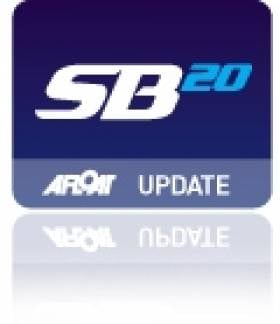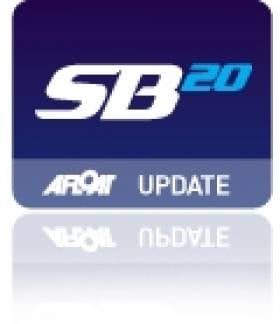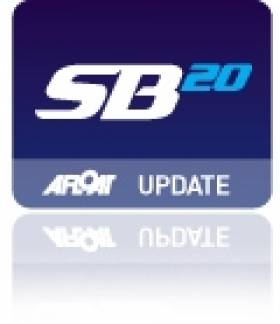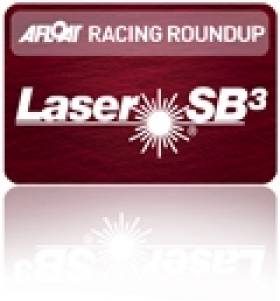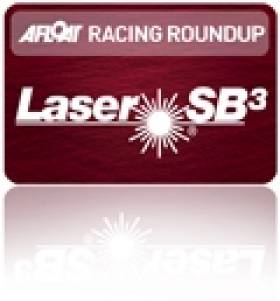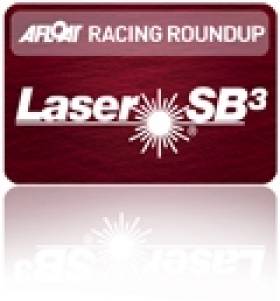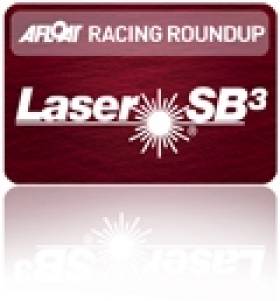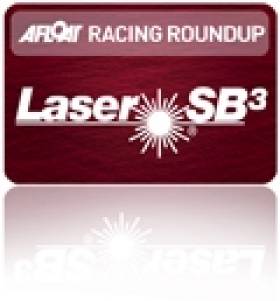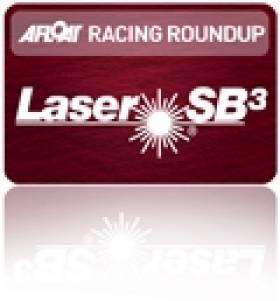Displaying items by tag: SB3
SB20 Grand Slam Starts in Hyeres
#sb20grandslam – The SB20 class is looking forward to its first Grand Slam event of the 2015 season at the stunning venue of Hyères in the South of France, this morning.
This is the first of four Grand Slam events for 2015, with Grand Slam regattas also scheduled at Torbole in Italy, Cowes on the Isle of Wight, and Cascais in Portugal for the one-design 20-foot keelboat class.
New for 2015, the first Masters team will be awarded prizes from sailmakers Hyde while the top Women's team will win luxury products from skincare company Clarins.
Hyères, on the Cote d'Azur, is famed as a superb sailing venue – just last week it hosted some of the world's best sailors at the ISAF World Cup event, welcoming top Olympic and Paralympic class competitors to the glamorous South of France. The SB20 class is returning to the venue for their third Hyères Grand Slam, and can look forward to three days of racing with up to 12 races scheduled by organisers COCYH, and spectacular sailing conditions forecast of strong breezes with plenty of sunshine.
The fleet has attracted 25 entries from eight countries, including France, Portugal, Russia, Germany, Britain, Monaco, Switzerland, and as far afield as Singapore but unfortunately none from the Irish fleet. Competitors include Alexey Muraskhkin, who won last year's Torbole Grand Slam event, and Class President Edward Russo.
"This is an exceptional location and we're expecting some exciting, high-octane racing over the next few days," commented Ed Russo, SB20 World Council President. "We are particularly pleased to welcome Hydes and Clarins onboard as category sponsors for this year's Grand Slam series, and are sure that the Masters and Women's teams will enjoy some superb competition in this international fleet."
The SB20 is one of the world's most successful one-design keelboats, with over 700 boats currently sailed in 22 countries. It is distributed worldwide by Sportsboat World in Netley Abbey and was originally designed by Tony Castro of Hamble, Hampshire. The 2015 World Championships will be held in Torbole, on Lake Garda in Italy from July 4-10, and the UK National Championships from September 5-8 at the Royal Southern YC in Hamble.
Former Irish SB3 Sailor Escapes Death In Everest Avalanche
#Nepal - A British woman who previously raced SB3s on the Irish sailing circuit has spoken of her miracle escape from an avalanche at Mount Everest during last weekend's Nepal earthquake disaster.
As the Daily Telegraph reports, Selina Dicker from Norfolk, who was on a climbing expedition to the word's highest peak, told how she outran the deadly wall of snow as it careened towards her group.
The avalanche claimed the life of fellow climber Daniel Fredinburg and left two others critically injured.
But Dicker narrowly avoided the same fate when she ran to a ridge at the edge of their base camp – and later contacted her relieved family by satellite phone to explain what happened.
Dicker should be familiar to Dublin Bay sailors from racing her SB3 named Kicker Off, and teaming with Wayfarer champ Trevor Fisher for the RS400 Sprint Trophy in October 2011.
The Daily Telegraph has more on the story HERE.
Seven SB20s Enjoy Decent Breeze for Thursday Night DBSC Race
#sb20 – Seven SB20s took to the water last night on Dublin Bay for the fourth Thursday of Series 2, many fresh from an exhilarating nationals in RCYC last weekend, while others were obviously recharging their batteries after their exertions in Cronins... :-)
For a pleasant change on a Thursday this season, we saw some decent breeze on Dublin Bay which allowed the SBs to get up on their toes and start dancing... A steady force 5 from the West guaranteed plenty of thrills and spills were to come... Perfect SB20 weather! The OOD set a 10 degree pin-end bias and the fleet duly congregated down at the pin with 30 seconds to go. At the start, Should Be... (Michael, Dave, and Gavan) managed to get the pin but Venuesworld (Marty, Ger and Rory), Probably (Mark, Ian and Billy) and Alert Packaging (Justin, Darren et al) all managed to start with better pace slightly up from the pin and those three boats quickly established a lead group beating up towards Harbour mark.
At the weather (Harbour) mark, Probably led by a boatlength from Venuesworld with Should Be...another 1/2 boatlength back. Alert Packaging, Timber (Alan et al), Seriously Bonkers (Peter et al) and Smoke on the Water (Bob, John et al) were very close astern and primed for the fast reach to Omega where speeds in the teens were experienced by most boats. At the all-important first hoist, Probably went trawling for mackerel followed by Should Be... allowing Venuesworld, Alert Packaging and Timber to pass and to take a jump on the fleet... However, there were a few broaches down the first reach keeping manners on everyone. Disaster struck Venuesworld when they snapped their port kite sheet allowing both Alert Packaging and Should Be... to overtake them shortly after the gybe mark on the run (ok, SB20s don't run in a force 5, we just reach very quickly a bit closer to the leeward mark!) en route to Poldy mark. Alert Packaging held on to their lead followed by Should Be... with Venuesworld, Probably and Timber in the thick of it at the leeward (Poldy) mark.
Places remained largely unchanged for the next beat and run (ok, again, not really a run but just lots of very, very fast reaching back and forth really!) and another beat with Alert Packaging extending their lead and looking very comfortable in the process. However, at the final weather mark, a twist in Alert Packagings kite necessitating a couple of gybes allowed Should Be... to close to within three boat lengths and ensure an exciting finale...
At the last leeward mark, Alert Packaging tacked shortly after the mark and headed left while Should Be... continued on right getting separation and in the hope of breeze or a favourable shift to get closer to Alert Packaging. In the end, Should Be... got both (they donate heavily to charity apparently!) and when the boats converged closer to the finish line, Should Be... had Alert Packaging by a whisker and they would finish in that order. They were followed by Venuesworld in third, Timber in fourth, Probably (who had showed their mettle and recovered very well) in fifth, Seriously Bonkers in sixth and Smoke on the Water in seventh.
As it was the last Thursday of the month, that meant SB Social food and pints... this month the fleet got together in the RIYC for the BBQ/stir-fry/pizza and, of course, pints. Lots of pints. No doubt some of them are still going strong!
Class notices:
Next SB Sunday (first SB Sunday of Series 3) is Sunday 10th August. Put it in the diary and get out there!
SB Sunday no. 3 is being re-sailed on August 17th (effectively, this is the last Sunday of series 1 (that was lost due to strong winds) being re-sailed). This is with kind permission and co-operation of both DBSC (Chris Moore and Joanne Sheehan) and our many volunteers (Barry O'Neill, Fionnuala Loughrey, Cathy Booth and Barbara Conway) so please show your appreciation by attending in numbers!
Westerns in Galway are on 23/24 August followed by Midlands in Lough Ree on 27/28 September. Two amazing venues with lots of fun and top quality racing guaranteed. I would strongly recommend those of you less inclined to travel to make the extra effort and see what all the hype is about.
See you on the water next Thursday,
Michael O'Connor
2013 SB20 Sportsboat Fixtures is Published
The Dublin Bay Sailing Club (DBSC) SB20 sportsboat fleet get together for a beer and a catch up in the Royal Irish YC at 8pm this Friday. The bay class, the biggest in the country with up to 20 boats, has its annual dinner on Friday 1 March 2013 at the Royal St. George YC and no doubt both functions will be opportunities to discuss both the local DBSC calendar and the national fixture list both of which were published this week.
One other topic up for discussion with DBSC SB20 captain Doug Smith over the winter has been the the possibility of the Dragon class joining in the SB20 Sunday sailing. Up to ten Dragons have indicated they would switch to Sunday from traditional Saturday racing. It is something of a compliment to the SB20 DBSC format and the windward/leward courses. Perhaps other classes, such as the Flying Fifteens and Squibs, might consider the same too if separate starts could be given?
(Proposed) DBSC SB20 Sunday Series in 2013
May – Sunday 5th, 19th & 26th
June – Sunday 23rd & 30th
July – Sunday 7th & 21st
August – Sunday 4th, 18th & 25th
SB20 2013 Irish Calendar
Spring Warmer Howth Y.C. April 6/13/20
Easterns Howth Y.C. April 27/28th
Westerns Lough Ree May 11/12th
Southerns (Kinsale) June 08/09th
Dun Laoghaire week July 11/14th
Nationals Galway July 26/28th
Northerns Aug 10/11th Royal Ulster
Worlds France Sept. 7th – 13 th
Midlands Lough Derg Oct 19/20th
#SB20 – The first SB20 event was held at TBSC over the weekend of June 30th/July 1st. Although the fleet was small the racing under PRO Peter Moore of the host club was of the highest quality. On Saturady the wind blew fro the NW with a vengeance. Gusts of 35 knots were recorded between the race 1 and race 2 but only 25 to 30 knots during the racing.
Race 1 was won by Ben Duncan's Sharkbait with a flawless display of heavy wind sailing. In race 2 however it was Scott McKeown's Magic who won the plaudits and the race. Two boats retired with damage during the race as the wind and waves took their toll. Sharkbait was the winner of race 3 with Magic in second. At this point the race officer decided that the fleet had had enough punishment for one day and even though it was still early sent them to the showers and the bar.
It was obviously a great party as even though one of the damaged boats reappeared on Sunday morning only eight boats made it to the startline. Conditions could not have been more different as a light and shifty SW breeze made for difficult conditions. Once again Peter Moore did an outstanding job and had three good races on the board by one o'clock with less than ten minutes between races.
Sharkbait made light of the conditions to score three bullets and won the last race of the event by an enormous margin to take the title with five wins and a second as a discard. In the Silver Fleet Ronan Downing recovered from a poor first day to take first and fourth overall.
Sail No Boat Owner Race 1 Race 2 Race 3 Race 4 Race 5 Race 6 Net Place
3287 Sharkbait B. Duncan 1 2 1 1 1 1 5 1
3490 Dinghysupplies S. Murphy 3 7 3 2 4 2 14 2
3198 Magic S. McKeown 2 1 2 6 6 7 17 3
3 Manamana R. Downing 10 8 4 4 3 3 22 4
3433 Boatmec.com D. Taylor 4 6 5 3 8 5 23 5
3449 Lia D. Barry 5 5 8 5 5 4 24 6
3338 MilvusMilvus R. Howe 8 4 7 7 2 6 26 7
3537 Boomsticks B. Reilly 6 3 6 11 11 11 37 8
35 R. Tate 7 11 11 8 7 8 41 9
3307 Bad Kilcullen J. Dowling 9 11 11 11 11 11 53 10
Sharkbait Wins National Yacht Club's SB20 Eastern Champs
#SB20 – Howth Yacht Club's Sharkbait Ben Duncan (3287) sailing with Brian Moran and Paul Adamson won the first of the 2012 SB20 sportsboat championships with three wins in a series cut short by strong winds at the National Yacht Club in Dun Laoghaire today.
Second in the 28-boat fleet was Aidan O'Connell (3072) Graham Elmes and Brian Reilly and third Rob Howe (3338) with Paul McDonland and Ross McDonald, the latter two fighting it out for second but O'Connell winning out on countback.
Full results downloadable in PDF format below.
#SB20 – Andrew Algeo's Flutter took overall honours but only by one point in the first outing of the reformatted DBSC SB20 Sunday races with second and third being determined by countback between three boats. 19 boats turned out for the three windward leeward races.
SinBin (Barry O'Neill) took second and SandyBottom (Gordon Judge) third.
Last week the sportsboat class changed its racing format on the bay and following international developments the class also got a name change from SB3 to SB20.
Next weekend the National Yacht club stages the SB20 Eastern championships on the Bay. A Notice of Race is available to download below.
The next DBSC Sunday racing is the 20th of May. Again first gun is 12.30 with 3 races
#SB3– Ireland's most successful ever sportsboat design the SB3 that produced over 100 boats racing in five different sailing centres is to undergo a world wide restructuring that will include a name change for the popular three man design and the loss of the Laser trademark. The boat which will now be known as the SB20 has over 650 boats sailing in 20 countries worldwide, and it achieved ISAF recognition in 2007.
The exsiting race programme including the World and European championships will continue exactly as planned a spokeswoman confirmed to Afloat.ie. The class website already bears the new class logo, URL and decals here.
The Laser trademark will not be used for the new boats, new sails and new spare parts according to Tony Castro in a press statement issued today. See the full Q&A below.
The Irish dealer network is expected to stay the same but there are some change in the worldwide dealer network.
The designer of the SB3 sportsboat Tony Castro has announced that the global sales and marketing of the hugely successful sportsboat is to be carried out by a new organisation Sportsboat World.
Sportsboat World is founded by SB20 designer Tony Castro. In partnership with Jerry Hill, Alan Hillman and Mark Richards, Sportsboat World will promote the design and manufacture of sportsboats. Jerry is a former UK Class Chairman and 2010 SB3 world champion, whilst Alan and Mark are the partners of the SB3 specialists firm Rigging Gurus.
Tony Castro has appointed White Formula in the UK, who built the first 50 boats in 2002, as the licensed SB20 builder. New boats have been ordered and are due for delivery from 1st August 2012. Parts are available with immediate effect from www.sportsboatworld.com and via a revised dealer network.
Sportsboat World will work with the SB20 World Council and National Associations to provide an event circuit to appeal to sailors internationally.
President of the SB20 World Council, Edward Russo (FRA) expressed his pleasure in the announcement of the developments for the SB20 class. "This is extremely good news for the SB20 class which is currently experiencing strong growth in several countries. I am especially pleased to see the SB20 production being moved back to the UK. The promise of quality new boats, a steady supply of spares as well as technical support means the SB20 will continue to provide cost effective, international one-design competitive sailing for a long time to come."
Glenn Bourke current Australian National Champion and 2012 Worlds host, is in full support of the new structure. "I am delighted to hear that the SB20 class is in the hands of people who have been racing in it since it's inception. Like everyone who loves this class, I look forward a seamless transition to the production of new high quality boats. We're ramping up for the Worlds in Hamilton Island in December and 2012 is shaping up to be yet another great year for the SB20!"
Further information and a full Q&A please see below:
Question and Answer
2nd May 2012
LICENSE AGREEMENT
What has changed?
Tony Castro, as the designer of the SB20, gave LaserPerformance (LP) the distribution rights to what has been known as the Laser SB3, through a Licence Agreement from 2001. This License Agreement has now been terminated. The reasons for its termination are confidential to Tony Castro and LP.
Who holds the license now?
Under the new structure Tony Castro retains the licence himself, and independently licenses the manufacturer of the boat, spars and sails. The new company Sportsboat World oversees the building of the boat, global sales distribution and general management.
NAME OF BOAT, LASER NAME AND SB20 TRADEMARKS
Will the boat name change?
The boat is now known as the SB20. The term Laser will no longer be used.
Why SB20?
The boat was originally called the SB3 as it was a "3 crew Sportsboat". This was not commonly understood, especially with many boats sailing with 4 crew. SB20 represents "20 foot sportsboat."
Will the Laser trademark continue?
No. The Laser trademark will not be used for the new boats, new sails and new spare parts.
Can the existing boat owners continue to use the Laser trademark (leave the Laser sticker on their boats and sails)?
Yes. There is no restriction on existing branding. New sails, new boats, websites, communication and events will use the new SB20 name.
GLOBAL DISTRIBUTION
How is the SB20 be managed?
The Head Office function is managed by Sportsboat World (SBW) in the UK. SBW will organise the
global distribution structure via licensed dealers around the world.
Will the existing Dealer network remain in place?
SBW are retaining most of the existing dealers, especially where they have been successful in building and supporting an existing fleet.
Who are Sportsboat World?
Please refer to the Press Release. SBW has premises around 5 miles outside of Hamble in the UK.
The Hamble river has the highest concentration of SB20's anywhere in the world, and the major suppliers are all represented close by.
Sportsboat World is the trading name of Sportsboat Group Limited. 11 Bury Farm, Curbridge, Hampshire, SO30 2HB, UK | Company reg: 7965040
Does Sportsboat World have other responsibilities?
SBW is the UK SB20 dealer.
How will SBW and its dealer network support the class?
SBW and its dealer network are working with the regional Class Association on events, to ensure that the racing is fun, competitive and in the right locations.
NEW BOATS
Can I buy a new SB20 now?
Yes.
Who do I contact for a new boat?
Visit www.sportsboatworld.com. The full global dealer list will be published shortly, but in the meantime, SBW will be able to help or point you in the direction of your dealer.
Where are the new boats built?
White Formula builds the SB20. They were the original builder in the UK. The decision to revert to them was based on build quality, shipping and logistics.
Will DK Boats continue to build SB20's?
No.
Has the new SB20 changed?
SBW will incorporate a number of small changes, to improve the sailing experience and iron out any
small technical issues. SBW are ensuring that the strict one design nature of the boat is maintained,
so any changes have no implications on the speed of the boat.
Who guarantees the new boats?
The manufacturer of boats, sails, spars and parts have warranties for the products they produce. The warranty process is managed by Sportsboat World and the respective dealers.
SAILS AND SPARE PARTS
Where do we buy new sails and spare parts?
All sails, spars and spare parts are available exclusively through the new SB20 dealer network.
Is there a sail levy?
Yes. A small sail levy will be paid directly to the World Council. This will be used to help fund events. This levy is included in the retail price.
EVENTS
What will the events be known as?
All future events will be held as the SB20 class. The official name will be changed at ISAF, and the
class constitution and class rules will be adjusted accordingly through appropriate procedures.
Does this change effect the 2012 European and World Championships?
No. These events will be run exactly as planned. There will simply be a class name change to the SB20.
SB3 One Design Class Adapts to Change on Dublin Bay
#SB3 – How sailing classes cope with recession has been a talking point over the winter months in yacht clubs across Ireland. Little spare time and sailors under financial pressure means all classes are re-evaluating what they are offering. It means many classes are seeking to re-engineer fixtures and events in order to meet the changing circumstances. Most agree that a strong club racing bedrock is essetial for any class to be successful in the longer term – there are quite a few high profile casualities who chose the 'events only' route and avoiding more classes falling by the wayside is going to be tricky.
Riding on the tail end of the wave of initial success, the SB3 class, one of the biggest in the country, has been having just this debate and it has made some decisions about safeguarding own future on Dublin Bay.
Sunday event style racing has been a major part of the success of the class on the Bay and Ireland is one of the few places in the world where there is a successful club racing scene for SB3s.
Since its arrival in Ireland about five or six years ago, the SB3 class has enjoyed spectacular success with more than 60 boats in the country.
Looking to the future the class administrators in Dublin Bay led by new class captain Doug Smith; Justin Burke and Barry O'Neill had intensive dialogue with SB3 sailors starting last Autumn seeking their views on how to build on past success.
After much debate and further consultation it was decided to trial a new formula for the 2012 season with the following key findings and results with some relevant to all classes in these difficult times.
The success of the SB3 class is reflected by:
• An active Club racing scene in Dublin Bay with entries of 25 +. Typical turn outs on Thursdays in the high teens and Sundays in the low teens
• A competitive Events Circuit with entries for the four regional events typically in the 20s (more than most keel boats would muster for their Nationals) and entries for the National Championships and the likes of Dun Laoghaire Week usually 40 + boats.
• Ireland hosted the inaugural class World Championship in the N Y C when more than a hundred SBs showed up. Since then the World Championship formula of 100 + boats was repeated in Lake Garda and Torbay and plans are in place for the next World Championship in Hamilton Island , Australia in December
The success in Dublin Bay was largely attributed to three factors:
1 An exciting boat, offering competitive one design racing at an affordable price -- nothing like rolling downhill in an SB with the kite up in a Force 4+ ! With the asymmetric kite so easy to control, crew needs of only 3, and minimum maintenance costs, the boat is simply a joy to own and sail
2 A mould breaking racing formula of offering event standard DBSC windward /leeward racing (so important for an asymmetric race boat ) on a Sunday in a largely empty Dublin Bay
3 The traditional Thursday trip around the cans -- improved significantly last year when DBSC introduced Committee Boat starts /finishes
SB3s are the biggest one design class racing on Dublin Bay
The Debate
Looking to the future, the class administrators in Dublin Bay led by new class captain Doug Smith; Justin Burke and Barry O'Neill had intensive dialogue with SB sailors starting last autumn seeking their views on how to build on past success . A number of themes emerged -- including:
• All thought the boat a joy to sail
• Some focused on Dublin Bay SC club racing -- while others preferred to focus more on the Events circuit
• This led to some debate reflecting the facts that :
• The Club Racing focused boats had some concerns about the commitment involved in campaigning properly in DBSC as in effect this tied up crews most /all weekends between April and end September = 5 months – a BIG ask these days !
• While the Events focused boats fretted they could never be really competitive in a DBSC Series when missing as many as four or five Sundays each season
All SB sailors agreed the Sunday DBSC racing was a winner. There was simply huge enthusiasm for a 2 p.m. sharp start + two competitive W/ L races and all finished by about 4 – 30. But how could the needs of the "Eventers" vs. the "Club Racers" are accommodated?
Towards a Solution
After much debate and further consultation with SB sailors -- it was decided to trial a new formula for season 2012 -- specifically :
• Take a fairly radical step and reduce the number of DBSC Sundays from around 20 Sundays to 10. Each DBSC Sunday in 2012 will start at 12 – 30 a.m. (rather than 2 p.m.) and have three W/ L races rather than two. This means that over the season the Club racers will do nearly as many DBSC races as in 2011 -- but more focused and time efficient.
• Ensure DBSC Sundays did not clash with Regional event week –ends
• Split the 10 Sundays into 5 Series of two Sundays – roughly two Sundays per month.
• As part of the re-engineering, the SB Class addressed the issue of Line Duty. While it is recognised that DBSC Line duty is vitally important, in effect this means one boat had to drop out each Sunday . The SB class drove a pairing arrangement with dinghy/PY classes so SB sailors do their duty on Saturdays and dinghy /PY crew help with SB sailing on Sundays – Nett result is better class turn outs all round.
The Result
The new format was widely accepted in that it means that:
• DBSC club racing focused boats would continue to have brilliant racing -- but more focused on 10 Sundays rather than around 20 with 3 races rather than 2 -- so some weekends off to do other things without losing points.
• Events focused boats can now do BOTH events and DBSC club racing without being penalised
• SBers wishing to race every weekend as in the past can do so by combining the Club + Regatta + Events circuits
A positive outcome of the re- engineering of the class offering is the arrival of a couple of new SBs to Dublin Bay + some garage stored SBs are now scheduled to be back on the race track and indeed Roger Bannon has been lured out of SB retirement as he went and bought a new SB. The new format DBSC SB formula kicks off this weekend and the National YC host the first Regional event (The Eastern Championships) on May 12th/13th.
With competitive second hand boats changing hands for between €8,000 and €10,000 the class says there will never be better chance to join in the fun!
Contacts
Class Captain Doug Smith ([email protected]) at the RIYC ; Barry O'Neill ([email protected]) at the R.St.G.YC. or Justin Burke ([email protected])) at the National YC. They are willing to arrange a trial sail for interested parties.
Call for Irish SB3s to Head for Scotland in 2012
#SB3 - As the Dublin Bay Sailing Club SB3 class debates the merits of Saturday versus Sunday club racing with a contracted fleet size next season there has been a call from the North for Irish crews to head to Scotland for a new championships on Loch Fyne next year.
There has been a great deal of effort put into developing the Laser SB3 class on the west coast of Scotland, not all of its has been successful to date.
But there a number of boats and crew committed to racing on the upper clyde for evening and weekend racing.
The class has previously failed to become established in Scotland, possibly as a result of high boat prices in the past according to local sources. However, with the availability of great value second hand boats, and the affordability of racing them, it looks set now to be a success, according to class exponent Doug Paton.
For the 2012 Laser SB3 Scottish Championships, the class are going to Loch Fyne to take part in the Scottish Series event. Here, says Doug, the class will benefit from their own one design class start and nine windward-leeward Races over 3 days organised by the Clyde Cruising Club.
Perhaps there is advice Irish crews can give to Scottish counterparts on the initial set up of the fleet. In 2007 the boat exploded on to the scene creating a national fleet of over 100 boats to instantly become the biggest noe design class in the country.
There will be free craning on 2nd & 4th June provided by Macleod Construction. The class will also benefit from free berthing at the new Portavadie Marina. The class has provisionally booked out the bunkhouse accommodation block in the very nice new development at the marina exclusively to the class. As a further draw intend to have class socials held between tarbert an portavadie with the added help of the water taxi service.
For further information contact Scottish SB3 Rep Doug Paton: [email protected]



























